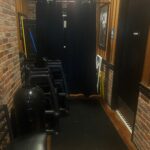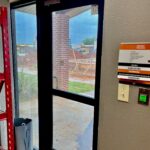 Imagine this…you have a single restroom where the property manager wants to install an automatic operator for easier access to the restroom (or to overcome a maneuvering clearance problem). How do you allow access but also give the person using the restroom privacy? If the restroom is empty, the door should open when someone pushes the actuator. If the restroom is occupied, the door should not open. How do you facilitate code-compliant egress from within the restroom, and also make the locking and unlocking of the door easy for users to understand?
Imagine this…you have a single restroom where the property manager wants to install an automatic operator for easier access to the restroom (or to overcome a maneuvering clearance problem). How do you allow access but also give the person using the restroom privacy? If the restroom is empty, the door should open when someone pushes the actuator. If the restroom is occupied, the door should not open. How do you facilitate code-compliant egress from within the restroom, and also make the locking and unlocking of the door easy for users to understand?
There are two potential scenarios – one where the door is not required to latch, and one where positive latching is required but there must be a means to unlatch the door so the automatic operator can function.
WWYD? What combination of products would you use for this application?
You need to login or register to bookmark/favorite this content.





I would install privacy bolt with a latchbolt sensor. When the privacy bolt is thrown the sensor trips a relay to bypass the auto operator. When the user is done and they unlock the privacy bolt the relay switches back and power is restored to the auto operator.
Lori – not hard at all as this is required by the new Ontario Building Code for a PUBLIC Universal Toilet Room. (So every restaurant etc!!)
1 Operator
2 Actuators
1 Storeroom function lockset
1 Electric strike, fail safe
1 Washroom control kit by Camden CX-WC 11 – push to lock, occupied when lite, door contact and logic control
1 Washroom control kit by Camden CX-WEC 10 – required by OBC – request for assistance, push button, lite, annunciator and signage
K.M. Thomas has similar washroom control kits too. Some manufacturers have integrated the “occupied when lite” into the actuators. There is a light bar around the actuator that changes colour depending if occupied (red) or vacant (green).
I agree, except in California we need 4 of the actuators from Camden. They don’t have a 36″ yet that illuminates. We also do not need the CX-WEC 10, but definitely could use it if the customer wanted it.
This is a very straight forward solution. Similar to a communicating bathroom without the second door. Would require control relays and potentially a timer. I can’t provide all the details right now…since I’m on the beach. But I will later today…
You read iDigHardware on THE BEACH??? I thought I was the only one! 😀
– Lori
There are multiple manufacturers that make washroom kits, where, on fail safe electric strike application, exterior actuator is illuminated green and is a push button to gain entry. Once inside, patron pushes a push to lock switch which energizes fail safe electric strike(locks) and turns exterior actuator Red – letting people know the washroom is occupied. Once patron is ready to exit, they can depress either the push to lock button, or, a handicap actuator inside the washroom. This de-energizes the electric strike and allows the operator to push door open. Likewise, the same washroom kit can be used with a fail secure electric strike (typically used with a card reader for security purposes).
This is a common scenario for us for the most part we use;
L9496L-03B-626-L583-363 Privacy deadbolt W/indicators and E-Z T Turn
HES 1006CDB This strike has a keeper for the deadbolt and is shallow enough to mount in most rated frames.
The operator is your standard power operator connected to the electric strike with the standard relay board.
When the room is unoccupied (lock is insecure) the handicapped button will open the door from either side.
When the room is occupied the deadbolt will secure the door into the keeper on the strike and pushes on the operator buttons will not open the door. Today’s operators are not adversely affected by users pushing on the button when the unit is secure. To reduce this the lock is equipped with an occupancy indicator.
To exit the secure room the user will need to push down on the lever and push the exit button.
If you have users who are severely handicapped (no arms) then you will need a different solution.
We have many of these on campus with no complaints so far, and no issues with maintenance.
Check on Camden Controls CX-33. It is an independent programmable logic board that will interface with electrified hardware, door operators, indicator lights and access control systems
That’s part of the Camden WC 11 kit. Camden packaged up everything you need.
BEA has a BR3-X for single bathroom applications that works well. Camden makes a CX-EMF-2 that requires a bit more effort to install.
Actually, the best solution comes from Camden Door Controls in Canada. They have series of Restroom Control Kits for single stall bathrooms that can be tied into a low energy operator. Go to their website http://www.camdencontrols and search for Restroom Control Kits. Great innovation!
As does K.M. Thomas. We require it as part of the Ontario Building Code.
You could use an interconnected lock with a Trine 3234 electric strike (T Strike). When unoccupied the strike would release and the door would open. Throw the deadbolt for privacy and the operator would detect resistance and would stop. You could include an IR sensor inside the bathroom if the operator doesn’t have a built in resistance sensor.
Laura’s solution is the fastest, easiest, simplest and most cost effective answer. Throw an occupancy indicator on that deadbolt (with ADA thumbturn) and you are good. I’m not sure if the monitor switch could be used to activate the operator or not. If not, you would need an inside actuator and would they consider that two operations? If they want a lever, use a mortise lock, privacy function with a deadbolt and REX (L9440P 06A L283-722 L583-363 RX), with an electric strike that will capture and monitor the deadbolt. Same idea as before. The RX can be used to signal the operator. If you’re really ambitious, throw some indicator lights near the outside actuator to show when it’s active and not. I just added several hundred dollars to the cost of this opening.
Just thought you would like to know that in California several places are requiring the handicap stall door to be on auto operator
Push button operator, with push/pull, electric strike and deadbolt w/ occupancy indicator.
Once again this blog is a wealth of experience and information.
We have a handicapped washroom with an auto opener and actuating switches outside and inside.
As above I installed a storeroom function lockset with an in-frame electric strike and intended to
fit a strike with a position switch to the privacy bolt to deactivate the outside button when the bolt is thrown.
Of course I ordered the wrong strike (give me a break this is a new one for me!) so the job has been put on the back burner
(As no-one has complained. 🙂 )
I will check out the Camden kits and see if I can talk our electricians into installing one. (They really don`t like new devices)
The amount of hardware required for a simple restroom door is mind-numbing.
My money is on a monitored strike and occupied indicator. We have numerous configurations and instructions mounted on the wall, no matter what someone will have a sit down and someone in the hall will push the actuator then it is behold as everyone walks by. there needs to be no prior knowledge on the operation of the system. I find the best way is the monitored strike and cylindrical deadbolt on a push pull door, or mortise, but then you would need an electrical strike complicating things.
I use the Camden products frequently.I have installed several of the CX-33 controllers where something like a CX-22 controller has been used in the past but the relays tend to hang up after a period of time.
I haven’t had that problem with the CX-33 units and they are very easy to wire.
I like the CM300/8R push to lock button because it lights red when the door is locked.
One of the issues with using the deadbolt of a mortise lockset is that as per the OBC, the handle must be operable by a fist. That rules out the thumbturn on a deadlock or deadbolt.
Looks like Ontario has gone beyond the norm, from what I’m seeing here.
Short of traversing down the complicated wormhole of Switches and Indicators (and cost), omitting the ADA Actuators and utilizing the Push-N-Go feature is a proven method. Successfully implemented on hundred of openings without incident.
Robbie has my vote on a simple solution.
But if needed ada buttons, strikes, locks and relays could certainly take care of this. If the property manager wanted, we could signal the air fresher to activate, run the exhaust fan for 5 minutes, turn the sink water off and flush the toilet with a valid “request to exit” and for the best part, signal an alarm/event in the VMS so management can determine who is stealing toilet paper. 🙂
I’m a little late to this party but here it goes. Electrical occupancy monitor w/relay (similar to automatic light switch) in toilet room would disable the outside actuator while occupied.
This system could also be tweaked to work in toilet room between two dorm rooms with “EL” function locksets.
Hi all. One thing I think is not being mentioned here is the necessity to re-set the system if the door is opened manually. If you are using a storeroom function lock and the occupant leaves the room by manually opening the door, you need to have a door position switch (or latchbolt monitor) to indicate that the door has been opened and should switch back to the “unoccupied” state. I prefer the simpler privacy with occupied indicator (and over sized T-Turn) with electric strike that captures the deadbolt as I think it is more intuitive.
It depends what the customer wants to spend, lockout package is the best way but I have also done it with indicator bolts or a privacy mortise set with a deadbolt and indicator.
Sometimes the customer doesn’t want to spend the $1000 or so to do this even though it’s the correct way
I know this is an old post, but I wonder if someone might help with a similar situation. I have a family restroom and a client who wants electronic control of the locks, to be able to remotely lock and unlock at the facility during hours of operation. It was spec’d by someone else as a storeroom function with Securitron strike and module. I assume they will also want the ability to manually lock/unlock with a key (and not a special tool). To provide the user the ability to lock the door, they want to add a deadbolt, but this will require two actions to unlatch the door. I’m relatively inexperienced with other than basic hardware, but I wonder if there’s a simple solution to this? My first thought was to switch to push/pull with deadbolt that has some sort of sensor, but I don’t know if deadbolts can be released electronically. I also looked at dormitory functions where (I think) you can deadbolt, but the inside lever will retract both the latch and deadbolt. Not sure how the electronic part of this would work… There isn’t a need for positive latching. I’ll take it up with a hardware rep, but I thought I’d put the question out there!
Hi Mike –
Is the lock a mortise lock or cylindrical lock? And is the hardware already installed or is it only specified?
– Lori
Not installed, but specified. New to project, so still familiarizing myself, but the spec’d hardware is cylindrical. Thanks! (PS I think I need to find a workshop or seminar about door hardware, so if you have any suggestions, I’d welcome those, too!)
Ok – that helps. A mortise lock would give us more options. The mortise lock could have a deadbolt (and possibly an occupied indicator) for use when someone is in the restroom. Turning the inside lever to leave the restroom would retract the deadbolt and latchbolt. The electric strike would have to be a type that will accept the deadbolt. The electric strike would allow the latchbolt to be pulled through the keeper when the restroom is unlocked and available for use, but the electric strike would not release the deadbolt when someone is inside. Take a look at the Von Duprin 6216 on this data sheet: https://us.allegion.com/content/dam/allegion-us-2/web-documents-2/DataSheet/Von_Duprin_6200_Series_Data_Sheet_105368.pdf.
For basic hardware education, I would recommend DHI’s online course – The Fundamentals of Opening Assemblies and Related Codes Bundle. It is available here: https://www.dhi.org/DHI/Education/Online-Courses/DHI/Education/Online-Courses.aspx?hkey=241eaba5-cc5e-4565-9b81-e3d32fcfdaa3.
– Lori
I’ll pass this along, but I don’t know about switching to mortise locks at this point. No option you can think of with cylindrical? If I can’t come up with something else, then at least we have something. Thanks for your help, and the recommendation.
I just noticed that you posted this question on a post about auto operators. Does this door have an auto operator?
– Lori
No operator. I read both this post and one on single action hardware for unisex restrooms, but posted here since there was more conversation about the relationship between the mechanical hardware and electronics. Thanks again!